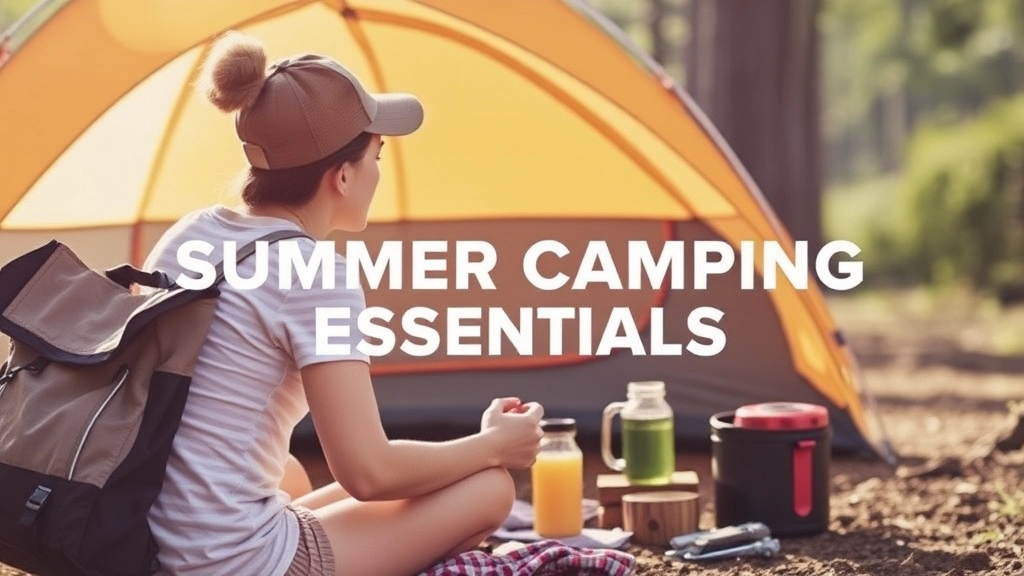Summer Camping Essentials
Summer camping is an exhilarating way to connect with nature, but it requires thoughtful preparation to ensure a smooth and enjoyable experience. In this guide, we’ll cover the critical summer camping essentials, from selecting the right tent and sleeping gear to packing cooking equipment, clothing, and safety supplies. Whether you’re a seasoned camper or a newbie, these tips will help you make the most of your outdoor adventure.
Camping Gear Checklist
We’ll dive into an essential camping gear checklist, explore how to choose the perfect tent, and discuss the importance of comfortable sleeping bags and pads. We’ll also cover camp cooking equipment, appropriate clothing, and crucial safety and first aid supplies. Additionally, we’ll look at navigational tools, personal hygiene practices, and fun activities to keep everyone entertained. Lastly, we’ll highlight eco-friendly camping practices to ensure we leave nature as pristine as we found it. So, gear up and get ready for an unforgettable summer camping experience!
Essential Camping Gear Checklist
Alright, let’s get real. You’re heading out into the wilderness, and the last thing you want is to be caught unprepared. Trust me, I’ve been there. So, let’s dive into the essential camping gear checklist you need to make your adventure smooth and enjoyable.
Why You Need an Essential Camping Gear Checklist
Ever been out in the middle of nowhere, only to realize you forgot something crucial? Yeah, it’s a nightmare. A solid checklist ensures you have everything you need, from the basics to those little extras that can make a huge difference.
The Must-Haves
- Tent and Shelter:
- Tent: Make sure it’s weather-appropriate and big enough for your crew.
- Ground tarp: Keeps moisture out and adds a layer of protection.
- Tent stakes and hammer: Because a tent that flies away is no fun.
- Sleeping Gear:
- Sleeping bag: Choose one suitable for the season.
- Sleeping pad or air mattress: Trust me, your back will thank you.
- Pillow: A little comfort goes a long way.
- Cooking Essentials:
- Portable stove: Reliable and easy to use.
- Fuel: Always pack extra.
- Cookware: Pots, pans, and utensils.
- Cooler: Keeps your food fresh and drinks cold.
- Water bottles and hydration system: Staying hydrated is non-negotiable.
- Clothing and Footwear:
- Weather-appropriate clothing: Layers work best.
- Hiking boots: Comfortable and durable.
- Extra socks and underwear: You can never have too many.
- Safety and Navigation:
- First aid kit: Better safe than sorry.
- Map and compass/GPS: Don’t rely solely on your phone.
- Headlamp or flashlight: With extra batteries.
- Personal Items:
- Toiletries: Toothbrush, toothpaste, biodegradable soap.
- Towel: Quick-dry is best.
- Sunscreen and insect repellent: Protect yourself from the elements.
Pro Tips for Packing
- Lists are your friend: Break down your checklist into categories. It makes packing less overwhelming.
- Test your gear: Set up your tent and try out your stove before you leave. You don’t want any surprises.
- Pack smart: Use compression bags for clothing and keep frequently used items easily accessible.
Real Talk: Stories from the Trail
I remember my first camping trip where I forgot a ground tarp. It rained, and I woke up in a puddle. Not fun. Another time, I didn’t pack enough fuel for the stove and had to eat cold beans. Lesson learned: always double-check your gear.
Final Thoughts
Your essential camping gear checklist is your lifeline out there. It might seem like a lot, but trust me, being prepared makes all the difference. So, pack smart, test your gear, and get ready for an unforgettable adventure. And hey, if you think of something I missed, drop it in the comments. Let’s make this the ultimate guide for all campers.
For more tips on staying comfortable during your camping trip, check out our guide on summer camping clothes. And if you’re planning a camping trip with kids, don’t miss our article on fun and safe summer camp programs for children.
Choosing the Right Tent
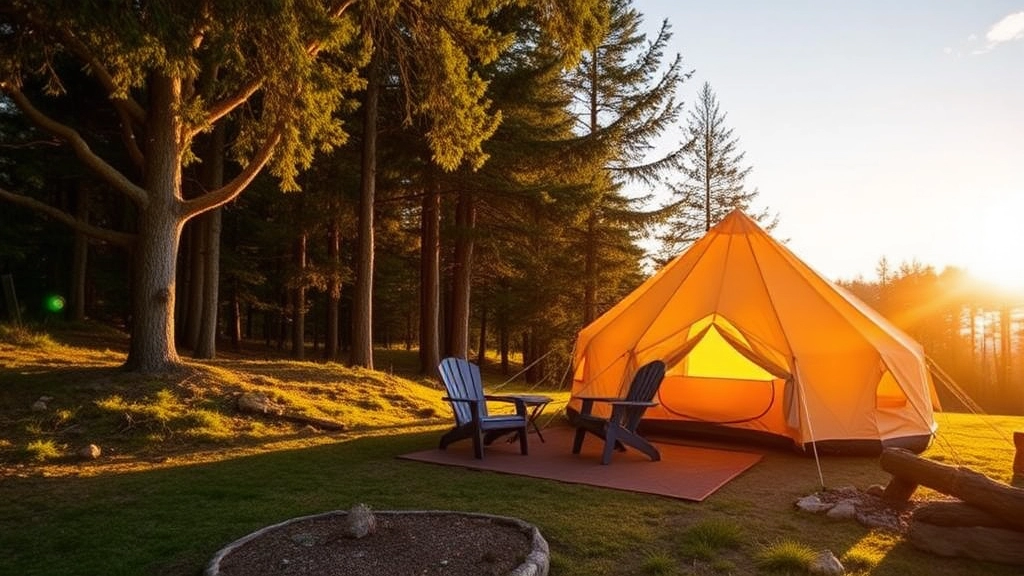
Alright, you’re gearing up for a camping trip, and the first thing on your mind is probably the tent.
How do you choose the right one?
What if it rains?
What if it’s too small?
I get it.
Picking the perfect tent can be a headache.
But don’t worry, we’re going to break it down, step by step.
Size Matters
First things first, how many people are you camping with?
If it’s just you, a solo tent works.
But if you’re with mates or family, you need a larger one.
Pro Tip: Always go for a tent that’s one size bigger than you think you need. Trust me, you’ll appreciate the extra space.
Weather Conditions
What’s the weather forecast?
If you’re camping in summer, a lightweight tent with good ventilation is key.
But if there’s a chance of rain, make sure your tent is waterproof.
Look for a rainfly and taped seams.
No one likes waking up in a puddle.
Ease of Setup
Nobody wants to spend hours wrestling with tent poles.
Check if the tent is easy to set up.
Freestanding tents are usually simpler and quicker.
Look for colour-coded poles and clips.
Less hassle, more time to enjoy the great outdoors.
Weight and Portability
If you’re hiking to your campsite, the weight of your tent is crucial.
Go for something lightweight and compact.
Backpacking tents are designed for this purpose.
But if you’re driving to your spot, a heavier tent with more features might be worth it.
Durability
You want a tent that lasts, right?
Check the material.
Ripstop nylon is a good option.
Also, look at the tent’s poles.
Aluminium poles are strong and light, while fibreglass poles are cheaper but can break more easily.
Ventilation
Good airflow is a must, especially in summer.
Look for tents with mesh panels.
They keep the bugs out but let the breeze in.
No one enjoys a stuffy tent.
Extra Features
Think about the little things that make a big difference.
Vestibules for storing gear, interior pockets for small items, and gear lofts for extra storage.
These features can turn a good tent into a great one.
Real Story Time
Last summer, I went camping with a tent that was supposedly “easy to set up.”
Turns out, it was a nightmare.
The poles didn’t fit right, and I ended up spending two hours just to get it standing.
Lesson learned: always check reviews and setup videos before you buy.
Sleeping Bags and Pads for Comfort
Ever had a camping trip ruined by a terrible night’s sleep? Yeah, me too. Let’s talk about how to avoid that nightmare with the right sleeping bags and pads.
Why Comfort Matters
When you’re out in the wild, a good night’s sleep isn’t just a luxuryâit’s a necessity. You need to be well-rested to enjoy the hiking, swimming, or whatever else you have planned. So, how do we make sure we sleep like a baby under the stars?
Picking the Perfect Sleeping Bag
First off, let’s break down what makes a sleeping bag comfortable:
- Temperature Rating: This is crucial. You don’t want to be shivering all night or sweating buckets. Check the temperature rating and match it to the weather conditions you’ll be camping in.
- Shape and Size: Mummy bags are great for heat retention, but if you like more wiggle room, go for a rectangular one. Make sure it’s long enough for your height.
- Insulation Type: Down insulation is super warm and lightweight but can be pricey and loses its insulating power when wet. Synthetic insulation is bulkier but performs better in damp conditions.
Sleeping Pads: The Unsung Heroes
Don’t underestimate the power of a good sleeping pad. Here’s why they matter and what to look for:
- Thickness and Material: Thicker pads generally offer more comfort. Look for materials that provide good insulation from the cold ground.
- Inflatable vs. Foam: Inflatable pads are more comfortable but can puncture. Foam pads are durable but less cushy. Some people even double up for extra comfort.
- R-Value: This measures the pad’s insulation. Higher R-values mean better insulation. Aim for an R-value of at least 3 for summer camping.
Real Talk: My Camping Experience
I remember this one trip where I thought I could get by with a cheap sleeping bag and no pad. Big mistake. I ended up wrapping myself in all my clothes and still felt like I was lying on a bed of rocks. Trust me, investing in good gear is worth every penny.
Quick Tips for Extra Comfort
- Layer Up: Use a liner inside your sleeping bag for added warmth and hygiene.
- Pillow Talk: Bring a small pillow or use a stuff sack filled with clothes.
- Site Selection: Choose a flat, dry spot for your tent. Clear away any rocks or sticks before setting up.
In the end, your sleeping bags and pads can make or break your camping experience. Don’t skimp on these essentials. A good night’s sleep means you’ll wake up refreshed and ready to tackle the day’s adventures. And remember, comfort is key, whether you’re a seasoned camper or a newbie.
Ready to dive into more camping essentials? Check out our guide on Summer Camp Packing List Essentials and make sure your whole camping experience is as comfortable as your sleep. For more tips on staying comfortable and safe, don’t miss our Top Features of Summer Camp Buildings.
Camp Cooking Equipment and Utensils
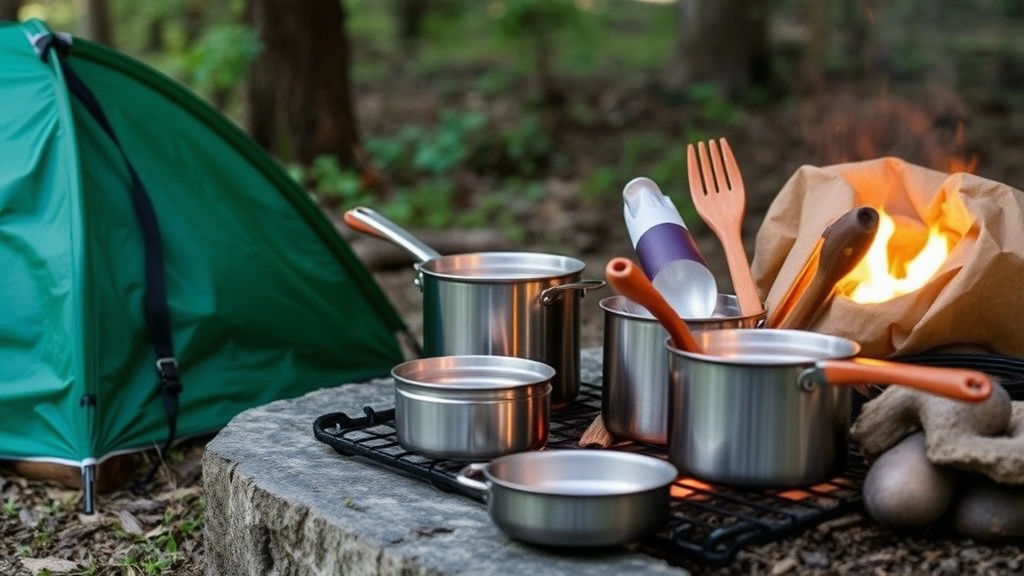
Ever been out in the wild and realised you forgot the can opener? Yeah, not fun.
Let’s make sure that doesn’t happen.
Essential Cooking Gear
First things first, camp stove.
You need a reliable one.
Check if it’s easy to set up and lightweight.
And don’t forget the fuel.
Running out mid-cook is a nightmare.
Must-Have Utensils
- Pots and Pans: Go for nesting ones. Saves space.
- Spatula and Tongs: Grilling without these? Good luck.
- Cutting Board and Knife: Don’t chop veggies on a rock. Trust me.
- Can Opener: Essential. You’ll thank me later.
- Sporks: Fork and spoon in one. Genius.
Food Storage
Keep your food fresh and safe.
- Cooler: Invest in a good one. Ice retention is key.
- Dry Bags: Keep your dry goods dry. Obvious, right?
Cleaning Up
No one likes a messy camp.
- Biodegradable Soap: Eco-friendly is the way to go.
- Scrubbers and Sponges: Keep it clean.
- Trash Bags: Leave no trace. Always pack out what you pack in.
Pro Tips
- Pre-Plan Meals: Saves time and stress.
- Prep Ingredients at Home: Chop, marinate, and pack in zip-locks.
- Multi-Use Items: A pot that’s also a bowl? Brilliant.
Real Talk
Last summer, I forgot my spatula. Flipping pancakes with a fork? Not recommended.
So, double-check your list.
Your future self will thank you.
Cooking in the great outdoors can be a blast if you’re prepared.
So, pack smart and enjoy the feast under the stars.
Clothing and Footwear for Summer Camping
Ever wondered what to wear on a summer camping trip? Yeah, me too. Let’s get real â the right clothing and footwear can make or break your adventure. No one wants to be too hot, too cold, or blistered up halfway through a hike. So, what’s the deal with summer camping gear?
Tops and Bottoms: Keep It Cool and Comfortable
The keyword here is comfort. You want clothes that are breathable, quick-drying, and offer some protection from the sun. Here’s what I usually pack:
- Moisture-Wicking T-Shirts: These keep you dry and cool. Cotton is a no-go because it absorbs sweat and takes forever to dry.
- Long-Sleeve Shirts: A lightweight, long-sleeve shirt can protect you from the sun and those pesky insects.
- Convertible Trousers: These are lifesavers. Zip off the legs when it’s hot and zip them back on when it cools down or when you’re walking through brush.
Layering: Be Ready for Any Weather
Even in summer, temperatures can drop at night. Layering is key:
- Fleece Jacket or Lightweight Hoodie: Perfect for those chilly evenings around the campfire.
- Rain Jacket: Weather can be unpredictable. A packable, waterproof jacket is essential.
Footwear: Your Feet Will Thank You
Good footwear is non-negotiable. Here’s what works:
- Hiking Boots: Opt for lightweight, breathable boots with good ankle support. Break them in before your trip to avoid blisters.
- Sandals or Camp Shoes: After a long hike, your feet will want a break. Sandals or lightweight camp shoes are perfect for lounging around the campsite.
Accessories: The Small Stuff Matters
Don’t overlook the little things. They can make a big difference:
- Hats: A wide-brim hat for sun protection and a beanie for cooler nights.
- Sunglasses: Protect your eyes from UV rays.
- Socks: Invest in moisture-wicking, cushioned socks. Wool blends are great because they manage moisture and temperature well.
Real Talk: What Works for Me
I remember my first summer camping trip â I packed all wrong. Cotton everything, no layers, and flimsy trainers. By day two, I was sweaty, cold at night, and my feet were killing me. Now, I stick to the essentials listed above, and my trips are way more enjoyable.
Final Tips: Keep It Light and Practical
- Pack Light: Overpacking is a rookie mistake. Stick to versatile pieces that can be mixed and matched.
- Stay Practical: Function over fashion. You’re not walking a runway; you’re out in nature.
For more tips on camping gear, check out our Essential Tips and Ideas for Summer Camping Outfits. Stay prepared, stay comfortable, and most importantly, enjoy the great outdoors!
Looking for some fun activities to do while camping? Discover Summer Camp Activity Ideas for Endless Fun to make your trip unforgettable.
Safety and First Aid Supplies
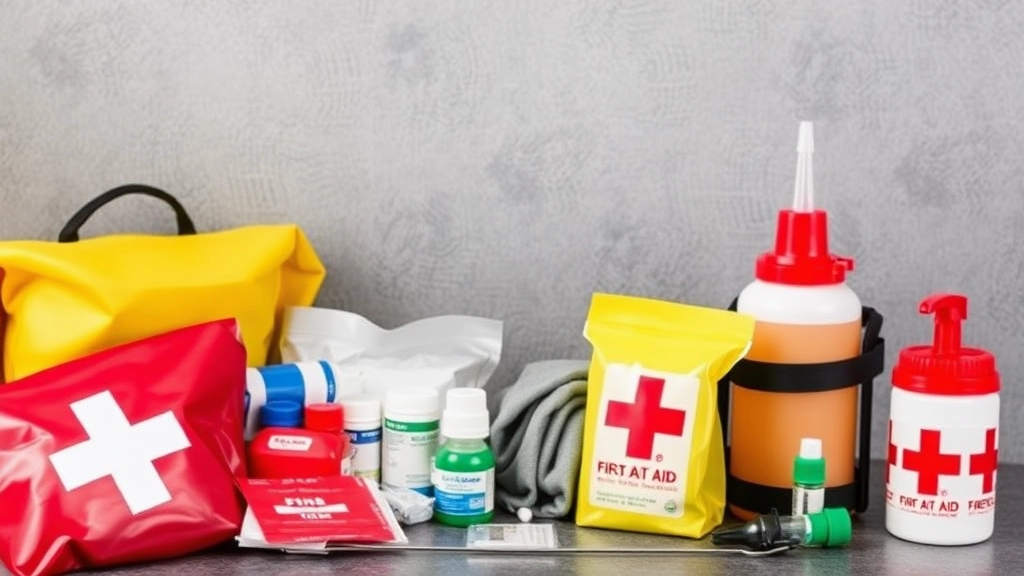
Alright, let’s be real for a second. Ever been out in the middle of nowhere and realised you forgot the first aid kit? Yeah, not fun. Safety and first aid supplies are non-negotiable when it comes to camping.
Why You Need It
First off, why do you need a first aid kit? Because accidents happen. Whether it’s a scraped knee, a bee sting, or something more serious, you want to be prepared.
Essential Items in Your First Aid Kit
So, what should you pack? Here’s a quick list:
- Bandages and plasters: For those inevitable cuts and scrapes.
- Antiseptic wipes: Clean wounds before they get nasty.
- Tweezers: Handy for splinters and ticks.
- Pain relievers: Think paracetamol or ibuprofen.
- Hydrocortisone cream: For rashes and insect bites.
- Gauze pads and adhesive tape: For larger wounds.
- Scissors: To cut tape or clothing if needed.
- Thermometer: To check for fevers.
- CPR mask: Just in case.
Pro Tips
- Check expiry dates: Medications and creams do expire.
- Personal meds: Don’t forget your prescription medications.
- Waterproof container: Keep everything dry and clean.
Real-Life Example
I remember this one time, my mate Dave got a nasty cut while setting up the tent. Luckily, we had our first aid kit and managed to clean and bandage it up right there. Could’ve been a trip-ender, but we were prepared.
Extra Safety Gear
Apart from the first aid kit, consider these:
- Emergency whistle: Signal for help if needed.
- Multi-tool: Swiss Army knife, anyone?
- Fire extinguisher: Small but mighty.
- Headlamp: Because you need your hands free.
Quick Recap
Don’t skimp on safety. A well-stocked first aid kit can turn a potential disaster into a minor hiccup. It’s all about being prepared.
And hey, if you’re keen on more camping tips, check out our sections on Essential Camping Gear Checklist and Choosing the Right Tent.
Navigational Tools and Maps
Ever been lost in the woods with no clue where you are? Yeah, me too. Navigational tools and maps are your best mates when it comes to camping, especially if you’re venturing into unfamiliar territory. Let’s dive into the essentials and make sure you’re never lost.
Why Navigational Tools Matter
First off, let’s get real. GPS devices are great until they run out of battery or lose signal. So, what’s the plan then? A reliable map and compass can be lifesavers. Here’s why:
- Reliability: Maps and compasses don’t rely on batteries.
- Accuracy: They provide a clear picture of your surroundings.
- Backup: Always good to have a backup plan.
Must-Have Navigational Tools
Alright, let’s break down what you need:
- Topographic Maps: These show the terrain, elevations, and landmarks.
- Tip: Get maps specific to your camping area.
- Compass: Learn how to use one. Trust me, it’s not that hard.
- Tip: Look for a compass with a sighting mirror for better accuracy.
- GPS Device: Handy but don’t rely solely on it.
- Tip: Carry extra batteries or a portable charger.
- Altimeter Watch: Measures altitude, helping you understand your elevation.
- Tip: Useful in mountainous terrain.
- Smartphone Apps: Apps like Gaia GPS can be great but remember, they need power and signal.
- Tip: Download maps for offline use.
How to Use These Tools
You’ve got the gear, now what?
- Read the Map: Understand symbols, scale, and contour lines.
- Orient the Map: Align it with the terrain using your compass.
- Plot Your Course: Mark your route and key landmarks.
- Check Your Position: Regularly check your position to ensure you’re on track.
- Use Landmarks: Identify mountains, rivers, or other features to navigate.
Real-Life Example
Imagine you’re on a hiking trip in the Lake District. Your GPS dies halfway through the trek. Panic sets in, right? But wait, you pull out your trusty map and compass, plot your location, and confidently continue your journey. Crisis averted.
Internal Linking Opportunities
Navigational tools are just one piece of the puzzle. For more on essential camping gear, check out our comprehensive guide on summer camp maps. And when you’re ready to set up camp, don’t miss our guide on summer camp cabin safety and design tips.
Personal Hygiene and Sanitation
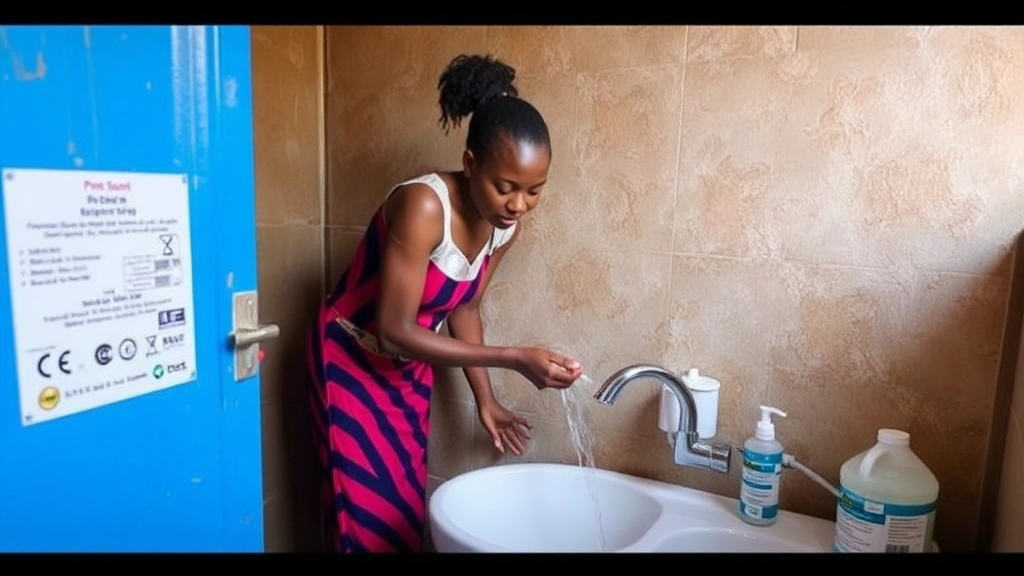
Alright, let’s get real for a moment.
You’re out camping, having a blast, but then it hits you: how do you stay clean and fresh when you’re miles away from your bathroom?
Personal hygiene and sanitation are huge concerns when you’re out in the wild.
Let’s break it down.
Keeping Clean in the Great Outdoors
You don’t need a full spa setup, but you do need the essentials.
Here’s what I always pack:
- Biodegradable soap: Keeps you clean without harming the environment.
- Wet wipes: Perfect for a quick refresh when water is scarce.
- Hand sanitiser: A must-have for keeping those hands germ-free.
- Toothbrush and toothpaste: Because bad breath is never fun.
- Microfibre towel: Dries quickly and takes up minimal space.
Handling Nature’s Call
This is where it gets tricky for a lot of folks.
But trust me, it’s not as bad as you think.
- Trowel: For digging a “cat hole” when you need to go.
- Toilet paper: Bring a roll and pack it out in a sealed bag.
- Portable toilet: If you’re camping with a group or staying in one spot for a while, this can be a game-changer.
- Sanitary bags: For packing out used toilet paper and other waste.
Staying Fresh
Let’s face it, you’re going to sweat.
But you can still stay fresh with a few simple tips:
- Change clothes regularly: Especially your socks and underwear.
- Dry shampoo: Keeps your hair from looking like a disaster.
- Deodorant: Obvious, but often overlooked.
- Foot powder: Keeps your feet dry and odour-free.
Real Talk: Stories from the Trail
I remember my first camping trip.
I thought I could get away with just a bar of soap and a towel.
Big mistake.
By day three, I was feeling pretty gross.
Since then, I’ve always packed my hygiene kit, and it’s made all the difference.
Why It Matters
Good hygiene isn’t just about feeling comfortable.
It’s also about staying healthy.
Dirty hands can lead to stomach issues, and nobody wants to deal with that while camping.
Eco-Friendly Practices
Remember, we’re guests in nature.
Leave no trace by using biodegradable products and packing out all waste.
Entertainment and Activities for Campers
Ever gone camping and found yourself bored out of your mind? Yeah, me too. That’s why having a solid plan for entertainment and activities is crucial. Trust me, you don’t want to be the person staring blankly at the trees while everyone else is having a blast. So, let’s dive into some killer ways to keep everyone entertained and make your camping trip unforgettable.
Campfire Stories and Songs
Who doesn’t love a good campfire story? It’s a classic for a reason. Gather everyone around the fire, and let the storytelling begin. Whether you’re into spooky tales or hilarious anecdotes, the key is to engage everyone.
- Spooky Stories: Perfect for setting a thrilling mood.
- Funny Stories: Lighten up the atmosphere with some laughs.
- Personal Anecdotes: Share your own experiences to make it more relatable.
Outdoor Games
Outdoor games are a fantastic way to keep everyone active and entertained. From classics to modern twists, there’s something for everyone.
- Capture the Flag: A timeless game that never gets old.
- Frisbee: Simple but effective for some light-hearted fun.
- Scavenger Hunts: Create a list of items to find around the campsite. This can be a fun way to explore your surroundings.
Water Activities
If you’re camping near a lake or river, water activities can be a highlight of your trip. Just make sure everyone knows the safety rules.
- Swimming: Cool off and have fun in the water.
- Kayaking/Canoeing: Explore the water and get some exercise.
- Fishing: A relaxing way to spend your time and maybe even catch dinner.
Hiking and Nature Walks
Exploring the great outdoors is what camping is all about. Plan some hikes or nature walks to take in the scenery and get some exercise.
- Trail Hikes: Choose trails that suit your group’s fitness level.
- Nature Walks: Take it slow and enjoy the surroundings.
- Wildlife Spotting: Bring binoculars and see what animals you can spot.
Board Games and Cards
Sometimes, you just want to chill at the campsite. Board games and card games are perfect for those moments.
- Classic Board Games: Bring along favourites like Monopoly or Scrabble.
- Card Games: A deck of cards can provide endless entertainment.
- Portable Games: Look for travel-sized games that are easy to pack.
Photography and Stargazing
Capture the beauty of nature or spend a night under the stars. Both activities offer a peaceful and engaging way to spend your time.
- Photography: Bring a camera and capture the stunning landscapes.
- Stargazing: Lay back and enjoy the night sky. Use a stargazing app to identify constellations.
DIY Crafts and Projects
Get creative with some DIY crafts and projects. This can be a fun way to pass the time and create some memorable keepsakes.
- Nature Crafts: Use items you find around the campsite to create art.
- DIY Projects: Bring along some simple project kits.
- Journaling: Document your trip in a journal. It’s a great way to reflect and remember the experience.
Group Discussions and Debates
Sometimes, the best entertainment is just good conversation. Spark some interesting discussions or friendly debates.
Eco-Friendly Camping Practices
Ever wondered how to enjoy nature without harming it?
I get it.
We all want to have a good time but also be kind to Mother Earth.
So, let’s dive into some eco-friendly camping practices that are easy to follow and make a big difference.
Why Should We Care?
Look, we all love the great outdoors.
But if we don’t take care of it, it won’t be there for long.
Here’s the deal:
- Less waste means less pollution.
- Respecting wildlife keeps ecosystems balanced.
- Sustainable choices make for a better planet.
Pack It In, Pack It Out
This one’s a no-brainer.
Whatever you bring with you, take it back.
Simple, right?
- Carry reusable bags for your rubbish.
- Avoid single-use plastics.
- Bring a portable bin if you need to.
Choose Eco-Friendly Gear
Not all camping gear is created equal.
Some items are better for the environment.
- Biodegradable soap for washing up.
- Solar-powered lanterns instead of battery-operated ones.
- Recyclable or upcycled materials for your tent and sleeping bag. For more tips on essential camping gear, check out our Summer Camping Top Tips & Gear Essentials.
Respect Wildlife
We’re guests in their home.
So, let’s act like it.
- Keep your distance from animals.
- Don’t feed themâit messes up their diet.
- Stick to the trails to avoid disturbing habitats.
Leave No Trace
This is the golden rule.
Leave your campsite as you found it.
- Clean up all your rubbish.
- Don’t carve your name into trees or rocks.
- Use established fire rings if you’re making a campfire.
Sustainable Food Choices
Food can be a big part of camping.
Make it eco-friendly too.
- Buy local produce to reduce carbon footprint.
- Use reusable containers for your meals.
- Opt for plant-based mealsâthey’re lighter on the planet. For more tips on maintaining a balanced diet while camping, visit our Balanced Summer Camp Menu Ideas and Tips.
Water Conservation
Water is life.
Don’t waste it.
- Use a collapsible water container to store water.
- Turn off the tap when brushing your teeth.
- Wash dishes in a small basin instead of under running water.
Real Stories, Real Impact
I remember this one camping trip.
We were in the middle of nowhere, and a fellow camper left rubbish everywhere.
It was a mess.
We spent an hour cleaning up.
But you know what?
It felt good knowing we did our bit to protect the environment.
FAQs on Summer Camping Essentials
How do I choose the right tent for summer camping?
When choosing a tent, consider the size, weather conditions, ease of setup, weight, durability, and ventilation. Always opt for a tent that is slightly larger than your immediate needs for extra space.
What features should I look for in a tent for rainy weather?
Ensure your tent is waterproof by looking for features like a rainfly and taped seams. These will help keep you dry even in wet conditions.
Why is ventilation important in a summer camping tent?
Good airflow is crucial to prevent the tent from becoming stuffy. Look for tents with mesh panels that allow for ventilation while keeping bugs out.
What cooking equipment is essential for a camping trip?
Essential cooking gear includes a reliable camp stove, fuel, pots and pans, spatula, tongs, cutting board, knife, and a can opener. Nesting pots and multi-use items can save space.
How should I store food while camping?
Invest in a good cooler for items that need to stay cold and use dry bags for keeping dry goods safe. Proper food storage helps keep your food fresh and prevents attracting wildlife.
What should be included in a camping first aid kit?
Your first aid kit should include bandages, antiseptic wipes, tweezers, pain relievers, hydrocortisone cream, gauze pads, adhesive tape, scissors, a thermometer, and a CPR mask. Always check expiry dates and include any personal medications.
What hygiene products should I bring on a camping trip?
Pack biodegradable soap, wet wipes, hand sanitiser, toothbrush, toothpaste, and a microfibre towel. These essentials will help you stay clean without harming the environment.
How do I manage sanitation needs while camping?
Use a trowel to dig a “cat hole” for waste, bring toilet paper and pack it out in a sealed bag, consider a portable toilet for group camping, and use sanitary bags for waste disposal.
What are some tips for staying fresh during a camping trip?
Change clothes regularly, especially socks and underwear, use dry shampoo, deodorant, and foot powder to stay fresh and comfortable.
Why is good hygiene important while camping?
Maintaining good hygiene helps you feel comfortable and prevents health issues, such as stomach problems from dirty hands. Always practice eco-friendly habits by using biodegradable products and packing out all waste.
What extra safety gear should I consider bringing?
In addition to your first aid kit, consider bringing an emergency whistle, multi-tool, fire extinguisher, and a headlamp to enhance your safety while camping.
How can I make camp cooking easier?
Pre-plan and prep your meals at home, chop and marinate ingredients in advance, and pack them in zip-lock bags. Using multi-use items like a pot that doubles as a bowl can also save space and effort.
References
-
How to Choose a Tent: Expert Advice from REI
-
How to Choose the Best Tent for Backpacking by Backpacker
-
Best Backpacking Tents of 2024 by CleverHiker

